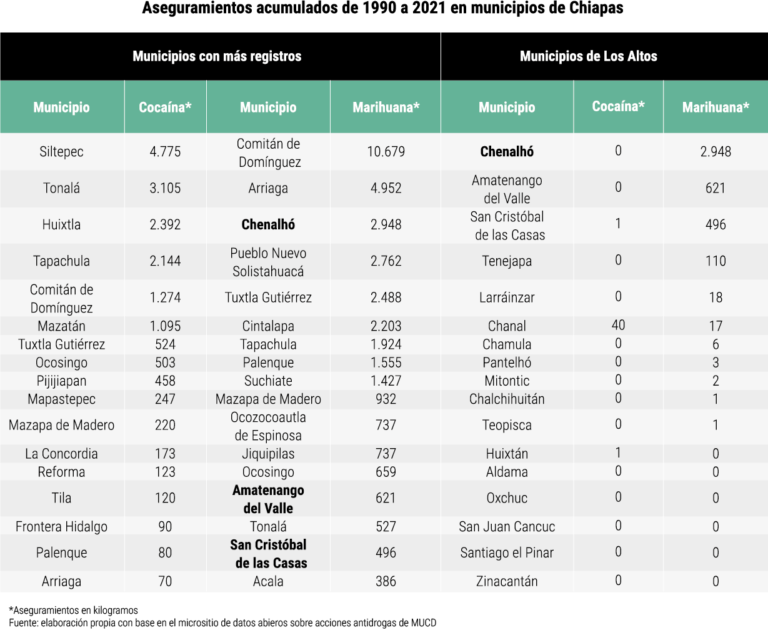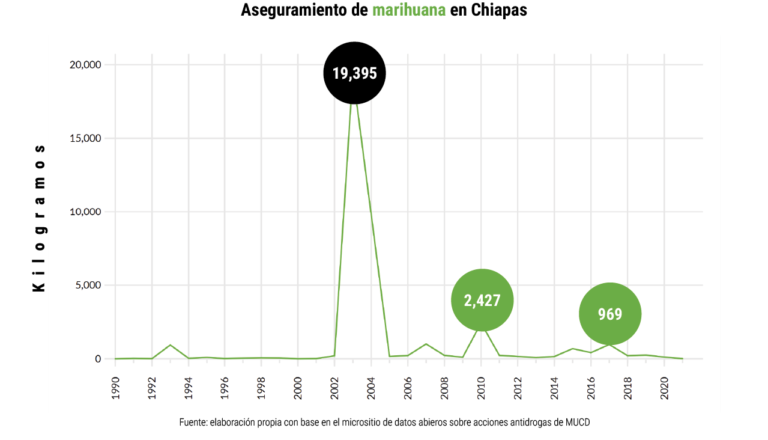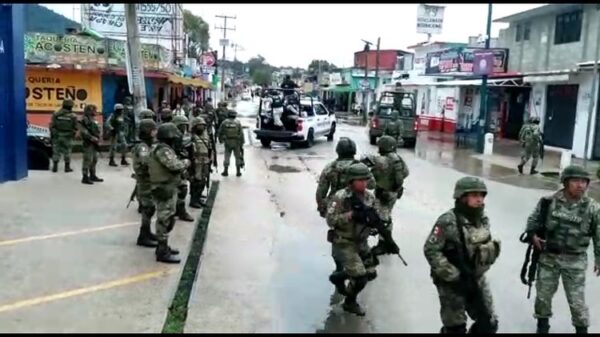March 11th, 2023

Mónica Daniela Osorio Reyes y Edgar Baltazar Landeros*
It has been almost eight months since June 14, 2022, in San Cristobal de las Casas, Chiapas, a group of armed civilians took over the northern part of the municipality, shooting in the air and setting fire to vehicles. After five hours of chaos, the armed group withdrew with impunity, without the intervention of security forces1. What has been locally called “the taking of San Cristóbal” is a recent milestone in the complex criminality and violence in Los Altos de Chiapas. It was an event that evidenced a deep-rooted conflict.
The armed civilians were identified as a group disputing the control of the Mercado del Norte, a strategic point for illegal activities2. Although carried out by different actors and for different reasons, these types of events are far from being isolated and, on the contrary, are examples of the complex web of historical violence in the region. The purpose of this contribution is to shed some light on this violence so that it can be addressed.
Structural violence3 is a characteristic feature of Los Altos4, where historical phenomena of racism, poverty5, paramilitarism and political-criminal bosses are interwoven. Despite this, these phenomena of violence and insecurity receive little attention, analysis and response, perhaps because conventional crime indicators do not place the state among the most victimized6. Moreover, we know that there are still significant gaps in data, explanations and interventions to explain and prevent or mitigate structural violence in Los Altos; and that this absence, coupled with the complexity of causes, consequences and actors who exercise such violence, prevents its recognition.

Two phenomena serve to analyze the structural nature of the violence and the lack of understanding and interest in what is happening in one of the most victimized and precarious regions of the country:
The existence of illicit economies and criminal actors in the region that does not unleash state action that is common in other states.
This is the case of anti-drug actions7, which in this part of the country are not carried out as frequently as in other states of the republic; even when criminal groups dedicated to their illicit trafficking have been identified in the region, such as the Chamula Cartel8.
According to the open database on anti-drug actions of México Unido Contra la Delincuencia (Mexico United Against Delinquency) in Chiapas the records of practically all categories of anti-drug actions are very low and only the seizures of marijuana stand out (for having the highest number of records from 1990 to 2021 with 38,237 kilograms) and, more recently, of cocaine9 (for registering a historic seizure of 1,297 kilograms of this substance in 2021).
At the municipal level, the relevance of these data lies not only in their potential underreporting, or the lack of connectivity of the few actions recorded with a strategy to address the structural violence experienced in the region, but also in the fact that, when observed closely, they reveal different dynamics depending on whether or not the municipality belongs to Los Altos.

For example, while for most of the state’s municipalities the annual information on drug seizures remains relatively stable and constant over time, for others such as Siltepec and Chenalhó, the latter located in the region of Los Altos, there are very few seizures, but when they do occur, the quantities of drugs seized reach historic highs10. In other words, in these municipalities there is an atypical pattern for an indicator that is in itself scarce for the state, but which could be a reflection of the dynamics of structural violence in the region: namely, the existence of paramilitary groups, the cacique control of the territory, the political use of violence and the lack of attention that the region receives from state and federal strategies and actions.
The existence and use of paramilitary groups in the region has not been addressed nor has it been discontinued.
Another indicator of the historical continuity of structural violence in Los Altos is the existence of paramilitary groups that were created as part of the counterinsurgency strategy of the 1990s11, with military assistance, sponsorship of local bosses and acquiescence of the authorities12. The continuity of these groups has had an impact on the forced displacement of communities. Three indigenous municipalities concentrate the largest number of displaced persons: Aldama (3,499), Chalchihuitán (1,237) and Pantelhó (3,205).
From Santa Martha, Chenalhó, paramilitaries carry out recurrent shootings against communities in the municipality of Aldama. From January to April 2022, 1,113 armed aggressions were registered against communities in Aldama13, leaving three people dead and five wounded. Journalists have calculated that from 2018 to March 2022, this conflict has left 30 people murdered, although when corroborating this information with data from the SESNSP, in both municipalities 23 investigation files for homicide were registered14. It is imperative to point out these sub-registries in order to begin to understand what is happening in Los Altos.
In July 2021, for example, an armed civilian group called “people’s self-defense El Machete”15 appeared in Pantelhó. By October of the same year, self-defense groups also appeared in the municipalities of Simojovel and Altamirano. In all three cases, these are indigenous municipalities that were experiencing post-electoral conflict due to the crisis of legitimacy of local family chiefdoms16.

The existence of various armed groups in Los Altos de Chiapas demonstrates the historical continuity of structural violence in the region. The recent appearance of “new” armed groups is not entirely new if one takes into account a social context where weapons and violence are central to the historical fabric of inequalities and permanent disputes.
The historical tensions between the political and criminal spheres in Chiapas, as in other parts of the country, do not allow us to speak of separate spheres but rather of networks of complicity and confrontation17. The permanent socio-political conflict, forced displacement, the unpunished operation of paramilitary groups and the systematic use of armed violence by cacicazgos add to a historical context of backwardness and marginalization that make Los Altos a permanently victimized region.
* Daniela Osorio is a sociologist from the Universidad Nacional Autónoma de México and a student of Data Science Engineering at the Universidad del Valle de México. She is a researcher for México Unido Contra la Delincuencia.
* Edgar Baltazar has a PhD in Social and Humanistic Sciences from the Universidad de Ciencias y Artes de Chiapas. Director of Research and Public Policy of México Unido Contra la Delincuencia.
Original article published in Chiapas Paralelo on March 11th, 2023. https://www.chiapasparalelo.com/opinion/2023/03/criminalidad-y-violencia-en-los-altos-de-chiapas/ English translation by Schools for Chiapas.
Footnotes
- Paradoxically, there is a significant military presence in Chiapas, with 12,830 military personnel deployed in 72 military posts. In addition, ten National Guard installations have been built in the municipalities of Palenque, Chilón, Frontera Comalapa, Las Margaritas, Huehuetán, Tapachula, Tonalá, Villaflores, San Cristóbal de las Casas and Bochil.
- The criminal group known as Los Motonetos operates in this market. This group is mainly made up of young Tsotsil youths who participate in criminal activities such as arms trafficking, extortion of merchants, sale of drugs, pornographic material of indigenous women and stolen cars.
- Structural violence derives from social structuring processes that have “negative effects on people’s opportunities for survival, well-being, identity and/or freedom”. La Parra Casado, Daniel and José María Tortosa Blasco (2003) “Violencia estructural. An illustration of the concept” in: Documentación Social, no. 131, p. 60. The power mechanisms of this type of violence cause “processes of deprivation of basic human needs” and include “ideas of deprivation, psychological harm, alienation, repression or inequality”. Villarruel Mora, Aarón (2017) “Violencia estructural: una reflexión conceptual” in: Vínculos. Sociology, analysis and opinion, no. 11, July-December, p. 15.
- The municipalities that make up the region of Los Altos de Chiapas are: Aldama, Amatenango del Valle, Chalchihuitán, Chamula, Chanal, Chenalhó, Huixtán, Larráinzar, Mitontic, Oxchuc, Pantelhó, San Cristóbal de Las Casas, San Juan Cancuc, Santiago el Pinar, Tenejapa, Teopisca and Zinacantán.
- According to CONEVAL data, in Chiapas 76% of the population suffers from poverty, 29% lives in extreme poverty, only 25% has access to quality food and 40% to health services.
- According to victim data provided by the Executive Secretariat of the National Public Security System (SESNSP), Chiapas is usually among the 15 entities with the fewest victims in the country.
- These have been recorded by MUCD in a database that retrieves information from 1990 to date, in relation to actions of crop destruction and seizure of illicit substances by the National Guard, SEDENA, SEMAR and the now defunct Federal Police.
- This group is also involved in other activities such as trafficking in people, fuel and wood, as well as in the production of pornography.
- It is worth noting that from 1990 to 2021 Chiapas was the fifth state with the most cocaine seizures.
- Siltepec (cocaine) in 1991 of 4,775 kilograms and Chenalhó (marijuana) in 20003 of 2,948 kilograms.
- The Chiapas 94 Campaign Plan saw the military training of civilian counterinsurgent forces.
- Galindo de Pablo, Adrián (2015) “El paramilitarismo en Chiapas” in: Política y Cultura, no. 44, pp. 189-213.
- One of the reasons for the conflict is the dispute over a 60-hectare plot of land.
- It should be clarified that the secretariat does not provide information on victims at the municipal level, so it is likely that within these 23 investigation files more than one victim can be found.
- A few days before the formation of the self-defense group, the human rights defender Simón Pedro Pérez López was murdered in that municipality. Initially, this group defined itself against the criminal group known as Los Herrera.
- Researcher Araceli Burguete presents a synthesis of the political processes involved in the construction of municipal councils.
- [17] In the recent political history of Chiapas, it is possible to observe this interweaving of the political and the criminal, with a preponderance in the Altos region. In September 2020, the leader of an armed group that disputed power with the mayor of Chamula was arrested. In April 2019, a former candidate for the municipal presidency of Bochil was arrested for leading an armed group that harassed the mayor of that municipality. In 2017 and 2018, a paramilitary group from Chenalhó caused the displacement of communities in Chalchihuitán. In 2017, the mayor of Chenalhó employed an armed group to recover the municipal presidency that was occupied by an antagonistic group. In 2018, the mayor of Yajalón irregularly created a “tactical” group as a parallel structure to the municipal police.
